 Features
Features
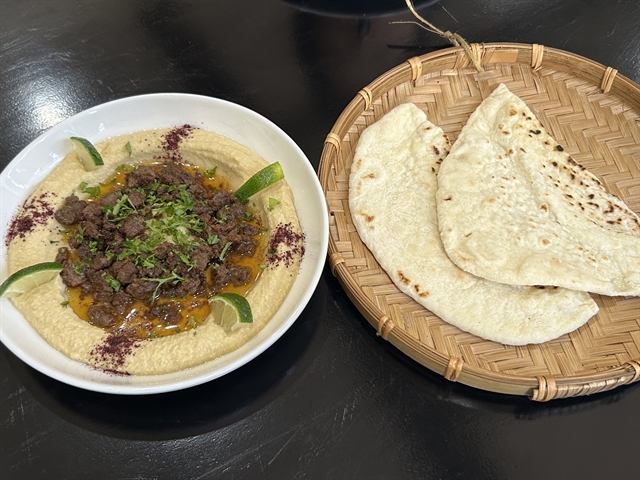
Having revived Pháp Lam art, a kind of enamel painting and carving on copper, in early 2000, local artisan Đỗ Hữu Triết refreshed the art on silver and gold for making fashionable jewelries, interior decoration and paintings.
By Công Thành
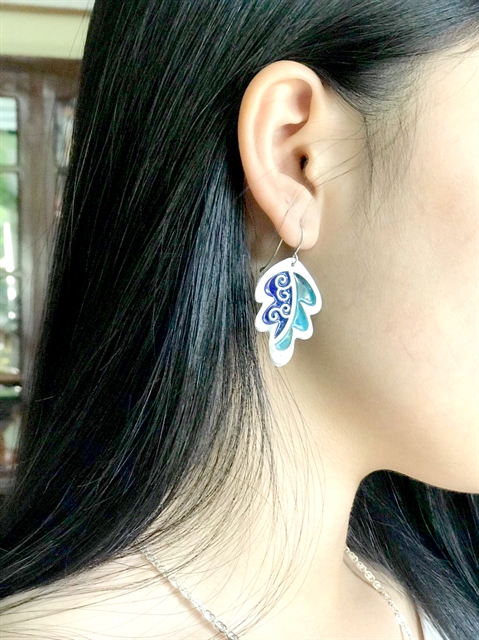
|
| BACK IN STYLE: Silver earrings with pháp lam enamel have helped revive the ancient Huế art form, with local artisans applying it to different materials and various fashion items. Photo courtesy of Đỗ Hữu Triết |
Having revived the art of pháp lam, a technique of enamel painting and carving on metals, mostly copper, in early 2000, artisan Đỗ Hữu Triết then adapted it to silver and gold to make fashionable jewellery pieces, interior décor items, and paintings.
Necklaces, earrings, curtains, and paintings can all be decorated with enamel, creating unique and practical fashion items and gifts.
By changing from copper to non-oxidising silver and gold, enamelled jewellery and paintings no longer need to be properly stored and preserved.

|
| MASTERPIECE: A model wearing a pháp lam enamelled necklace in an introduction to Huế. Photo courtesy of Đỗ Hữu Triết |
“It’s a new option in the art form’s long existence,” Triết explains. “Bronze or copper easily oxidises in Việt Nam’s tropical climate. Verdigris (greenish pigment) is found on the surface of bronze or copper objects after a time and requires cleaning.”
“Enamelled bronze jewellery is often heavy and dark in colour compared to silver and gold. So I tested the technique on new materials to promote it among fashionistas.”
The Huế-born artisan says it takes time to design the models and cast the moulds of the tiny patterns on earrings and necklaces.
“It’s finicky and skills are needed in adjusting the temperature in the thermal oven to retain the original colour of the enamel on the tiny designs,” he explains.
“I want to renew the pháp lam art form by creating fashionable jewellery and souvenirs based on the ancient art. Enamelled jewellery can help highlight suits and dresses at fashion shows or performances, while promoting the original culture and heritage of Huế.”
Lotus flowers and images of the former imperial capital city are the main focus of enamel paintings at Triết’s workshop near Đông Ba market -- a popular spot for tourists on the banks of the Hương (Perfume) River.
“Most paintings are created on laminated copper and covered by ceramic enamel before kilning at temperatures between 850 and 1,000 degrees Celsius for the preservation of colour and materials,” Triết says.
“I succeeded in melting down metal with ceramic enamel on paintings in the oven. By tuning in the temperature, bronze, ceramic enamel can be affixed to silver and gold. It’s a unique skill and ancient know-how of Huế.”
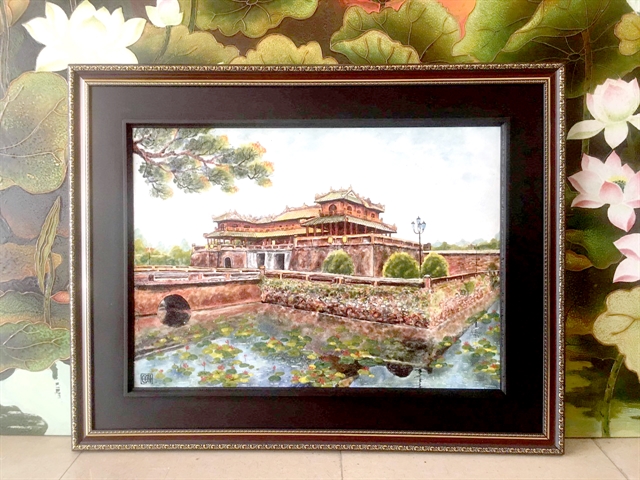
|
| ICONIC IMAGE: A enamel painting of the imperial Royal Palace in Huế. Photo courtesy of Đỗ Hữu Triết |
It’s not easy, however, because metal and enamel cannot mix under normal conditions and the two need a matching point in temperature to become a brightly-coloured artwork.
“The unique skills and secrets of the old art of Huế withered away in the past,” says Trần Nam Long, a skilled worker at the enamel painting workshop.
“As tourism boomed, the art form emerged as an attraction and gained extraordinary focus from tourists. We revived it not only for ourselves but also out of pride for Huế’s ancient culture.”
He adds that tourists should know the story of the art, as they do with UNESCO-recognised world heritages like the complex of Huế monuments and Huế folk music.
The enamel painting gallery on Chi Lăng Street is a centre of 10 artists mostly creating souvenirs, paintings, and interior décor items as well as working on relic restoration projects.
Nguyễn Quốc Hiếu, an artist, says the art form is being revived well in the modern world.
Artists in Huế have given the pháp lam art form a facelift and boosted its popularity in the tourism hub.
“We design and produce numerous pieces of enamelled artworks, including jars, paintings, home décor items and souvenirs,” Hiếu says. “It’s a renovation of old cultural features with a modern touch.”
Each piece, he says, costs a reasonable VNĐ1 million (US$43) to VNĐ3 million (US$130).
The innovative products are a different option for tourists seeking to take a piece of Huế home with them.
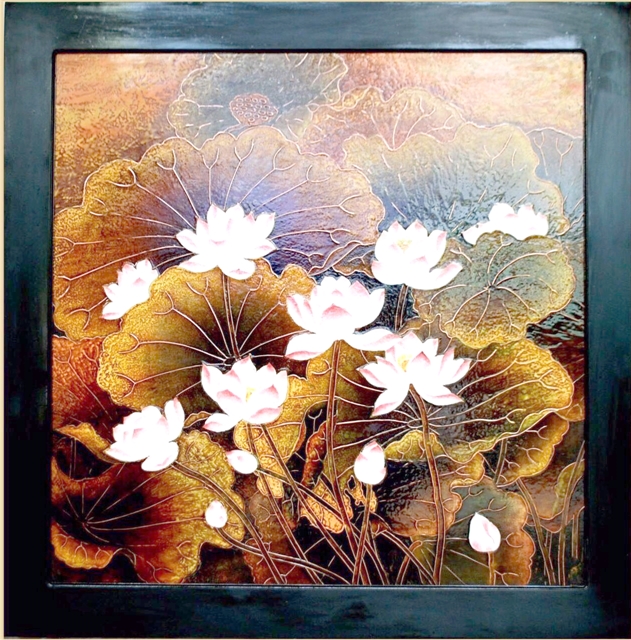
|
| FOCAL POINT: A pháp lam enamel painting of lotus leaves in Huế, with the lotus having been a focus of paintings since the artform was revived in the early 2000s. Photo courtesy of Đỗ Hữu Triết |
Hiếu says pháp lam -- a Huế specialty -- has been used on lacquer, glass, and wood to diversify the products on offer.
According to the management board of the complex of Huế monuments, the art form emerged in Huế under the reign of Emperor Minh Mạng from 1827 but had faded by 1842.
Enamelled objects from the previous century remain on display at the Huế Fine Arts Museum and on roofs of buildings of the Royal Palace and in the ruins of the tombs of Emperors Minh Mạng and Thiệu Trị.
Triết says some new homes in the city are also decorated with pháp lam artworks on the walls, ceilings and curtains.
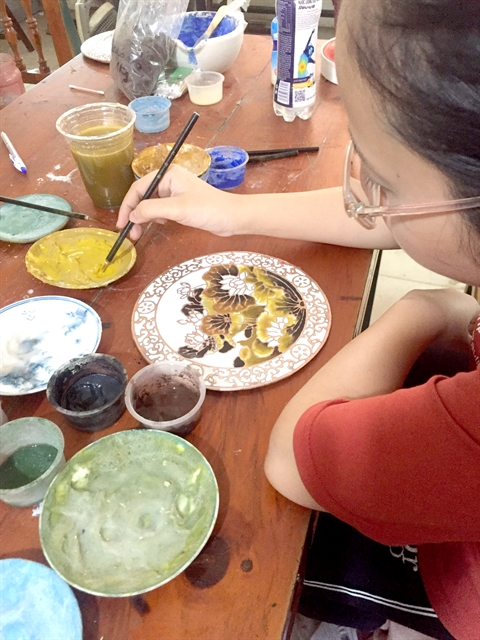
|
| SKILLED HAND: An artisan creating an enamel painting at a gallery in Huế. The ancient art form has attracted researchers and tourists alike for its unique colours and technique. Photo courtesy of Đỗ Hữu Triết |
Enamelled pieces of jewellery were worn by models wearing áo dài (the traditional Vietnamese long robe) at a fashion show held as part of the Huế Festival in 2012.
" The Huế pháp lam enamel painting art can brighten up traditional fashion collections at big shows as well as decorate costumes at events and parties,” Triết says.
“Enamelled gifts can help Huế create an amazing image of itself among international guests at diplomatic meetings or other gatherings.” VNS